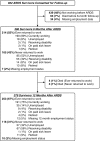Joblessness and Lost Earnings after Acute Respiratory Distress Syndrome in a 1-Year National Multicenter Study
- PMID: 28448162
- PMCID: PMC5649982
- DOI: 10.1164/rccm.201611-2327OC
Joblessness and Lost Earnings after Acute Respiratory Distress Syndrome in a 1-Year National Multicenter Study
Abstract
Rationale: Following acute respiratory distress syndrome (ARDS), joblessness is common but poorly understood.
Objectives: To evaluate the timing of return to work after ARDS, and associated risk factors, lost earnings, and changes in healthcare coverage Methods: Over 12-month longitudinal follow-up, ARDS survivors from 43 U.S. ARDSNet hospitals provided employment and healthcare coverage data via structured telephone interviews. Factors associated with the timing of return to work were assessed using Fine and Gray regression analysis. Lost earnings were estimated using Bureau of Labor Statistics data.
Measurements and main results: Of 922 consenting survivors, 386 (42%) were employed before ARDS (56% male; mean ± SD age, 45 ± 13 yr), with seven dying by 12-month follow-up. Of 379 previously employed 12-month survivors, 166 (44%) were jobless at 12-month follow-up. Accounting for competing risks of death and retirement, half of enrolled and previously employed survivors returned to work by 13 weeks after hospital discharge, with 68% ever returning by 12 months. Delays in return to work were associated with longer hospitalization and older age among nonwhite survivors. Over 12-month follow-up, 274 (71%) survivors accrued lost earnings, averaging $26,949 ± $22,447 (60% of pre-ARDS annual earnings). Jobless survivors experienced a 14% (95% confidence interval, 5-22%; P = 0.002) absolute decrease in private health insurance (from 44% pre-ARDS) and a 16% (95% confidence interval, 7-24%; P < 0.001) absolute increase in Medicare and Medicaid (from 33%).
Conclusions: At 12 months after ARDS, nearly one-half of previously employed survivors were jobless. Post-ARDS joblessness is associated with readily identifiable patient and hospital variables and accompanied by substantial lost earnings and a shift toward government-funded healthcare coverage.
Keywords: employment; health insurance; income; intensive care unit.
Figures



Comment in
-
Labor Market Outcomes: Expanding the List of Patient-centered Outcomes in Critical Care.Am J Respir Crit Care Med. 2017 Oct 15;196(8):946-947. doi: 10.1164/rccm.201705-0880ED. Am J Respir Crit Care Med. 2017. PMID: 28510473 No abstract available.
References
-
- Herridge MS, Cheung AM, Tansey CM, Matte-Martyn A, Diaz-Granados N, Al-Saidi F, Cooper AB, Guest CB, Mazer CD, Mehta S, et al. Canadian Critical Care Trials Group. One-year outcomes in survivors of the acute respiratory distress syndrome. N Engl J Med. 2003;348:683–693. - PubMed
-
- Herridge MS, Tansey CM, Matté A, Tomlinson G, Diaz-Granados N, Cooper A, Guest CB, Mazer CD, Mehta S, Stewart TE, et al. Canadian Critical Care Trials Group. Functional disability 5 years after acute respiratory distress syndrome. N Engl J Med. 2011;364:1293–1304. - PubMed
-
- Desai SV, Law TJ, Needham DM. Long-term complications of critical care. Crit Care Med. 2011;39:371–379. - PubMed
-
- Hopkins RO, Weaver LK, Collingridge D, Parkinson RB, Chan KJ, Orme JF., Jr Two-year cognitive, emotional, and quality-of-life outcomes in acute respiratory distress syndrome. Am J Respir Crit Care Med. 2005;171:340–347. - PubMed
-
- Huang M, Parker AM, Bienvenu OJ, Dinglas VD, Colantuoni E, Hopkins RO, Needham DM National Institutes of Health, National Heart, Lung, and Blood Institute Acute Respiratory Distress Syndrome Network. Psychiatric symptoms in acute respiratory distress syndrome survivors: a 1-year national multicenter study. Crit Care Med. 2016;44:954–965. - PMC - PubMed
Publication types
MeSH terms
Grants and funding
LinkOut - more resources
Full Text Sources
Other Literature Sources
Medical

